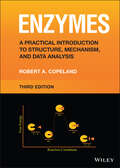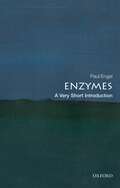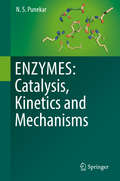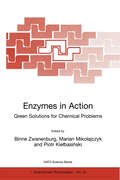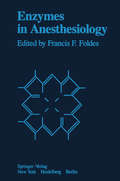- Table View
- List View
Enzyme-Prodrug Strategies for Cancer Therapy
by Roger G. Melton and Richard J. KnoxAntibody-directed enzyme prodrug therapy (ADEPT) directly addresses the major problem in cancer chemotherapy-its lack of selectivity. Antibody delivery combined with the amplification provided by the enzymatic activation of prodrugs enables selection to be made between tumour and normal tissue. ADEPT offers a novel field of opportunities in the therapy of systemic cancer and may be a major advance for the treatment of solid tumours. This book is the first to describe ADEPT in detail. Each chapter reviews an aspect of the immunology, enzymology, biochemistry, chemistry, and cancer chemotherapy which have been integrated into the ADEPT concept. An additional chapter describes the related approach of gene-directed enzyme prodrug therapy (GDEPT). This latter approach is still in its infancy but ADEPT has entered the clinic. The initial clinical studies with ADEPT are included and discussed in detail.
Enzyme Regulation in Metabolic Pathways
by Lloyd Wolfinbarger Jr.Enzyme Regulation in Metabolic Pathways shows the reader how to understand the roles of enzymes and their kinetic constants in intermediary metabolism. It provides a means of correlating data obtained in experimental studies to multiple possible mechanisms through which some enzyme may catalyze the conversion of a substrate to a product. Although not the most appropriate means of determining some potential kinetic mechanism, quasi-equilibrium assumptions are used throughout the book, keeping the rate equation derivations simple. Actual metabolic pathways with known (presumed) positive and negative regulation events are linked to these potential kinetic mechanisms using both rate equation derivations and data plots illustrating how the rate equation derivations can be used to explain the data plots. This book will be a valuable reference for students in biological sciences and biochemistry majors required to take a core course in enzymology.
Enzyme Regulation in Metabolic Pathways
by Lloyd Wolfinbarger Jr.Enzyme Regulation in Metabolic Pathways shows the reader how to understand the roles of enzymes and their kinetic constants in intermediary metabolism. It provides a means of correlating data obtained in experimental studies to multiple possible mechanisms through which some enzyme may catalyze the conversion of a substrate to a product. Although not the most appropriate means of determining some potential kinetic mechanism, quasi-equilibrium assumptions are used throughout the book, keeping the rate equation derivations simple. Actual metabolic pathways with known (presumed) positive and negative regulation events are linked to these potential kinetic mechanisms using both rate equation derivations and data plots illustrating how the rate equation derivations can be used to explain the data plots. This book will be a valuable reference for students in biological sciences and biochemistry majors required to take a core course in enzymology.
Enzyme Stabilization and Immobilization: Methods and Protocols (Methods in Molecular Biology #1504)
by Shelley D. MinteerThis volume introduces the reader to the field of enzyme stabilization and the different theories of enzyme stabilization, including the use of immobilization as a stabilization technique. The first part of the book focuses on protocols for enzyme stabilization in solutions including liposome formation, micelle introduction, crosslinking, and additives. The second part of the book discusses protocols for enzyme stabilization during enzyme immobilization, including common techniques like sol-gel encapsulation, polymer encapsulation, and single enzyme nanoparticle formation. Protocols for a variety of enzymes are shown, but the enzymes are chosen as examples to show that these protocols can be used for both enzymes of biological importance, as well as enzymes of industrial importance. The final part details spectroscopic protocols, methods, and assays for studying the effectiveness of the enzyme stabilization and immobilization strategies. Written in the highly successful Methods in Molecular Biology series format, chapters include introductions to their respective topics, lists of the necessary materials and reagents, step-by-step, readily reproducible laboratory protocols, and tips on troubleshooting and avoiding known pitfalls. Cutting-edge and thorough, Enzyme Stabilization and Immobilization: Methods and Protocols, Second Edition provides molecular biologists, biochemists, and biomedical and biochemical engineers with the state-of-the-art technical information required to effectively stabilize their enzyme of interest in a variety of environments (i.e., harsh temperature, pH, or solvent conditions).
Enzyme Stabilization and Immobilization: Methods and Protocols (Methods in Molecular Biology #679)
by Shelley D. MinteerIn the past decade, researchers have made tremendous progress in the field of enzyme stabilization, opening up new opportunities for enzymes in molecular biology and for industrial applications. In Enzyme Stabilization and Immobilization: Methods and Protocols, expert researchers explore the latest developments through detailed laboratory protocols, which address many different theories and techniques in enzyme stabilization. Chapters outline protocols for enzyme stabilization in solutions, including: liposome formation, micelle introduction, crosslinking, and additives. Secondly, the book contain protocols for enzyme stabilization via enzyme immobilization, such as sol-gel encapsulation, polymer encapsulation, and single enzyme nanoparticle formation. Composed in the highly successful Methods in Molecular Biology™ series format, each chapter contains a brief introduction, step-by-step methods, a list of necessary materials, and a Notes section which shares tips on troubleshooting and avoiding known pitfalls. Comprehensive and current, Enzyme Stabilization and Immobilization: Methods and Protocols is an essential handbook for all molecular biologists, biochemists, and biomedical and biochemical engineers.
Enzyme Technologies: Metagenomics, Evolution, Biocatalysis and Biosynthesis (Chemical Biology of Enzymes for Biotechnology and Pharmaceutical Applications #3)
by Hsiu-Chiung Yang James R. McCarthy Wu-Kuang YehAn authoritative review of the latest developments in the chemical biology of enzymes In the first decade of the twenty-first century, enzymes and their multiple applications have played a critical role in the discovery and development of many new therapeutic agents.This book is a coordinated compilation of research expertise and current opinion uniquely focused on enzymes and their properties and applications. Compiled by editors with a combined pharmaceutical experience of over sixty years, the text provides in-depth reviews of recent developments in selective topics on biosynthesis, biocatalysis, and chemical biology of enzymes as it applies to drug discovery, development, and manufacture. The first in a multi-part series on enzymes, this volume features three sections: New Approaches to Find and Modify Enzymes describes the emerging field of metagenomics, presents the practical applications of directed evolution to enzymes and pathways, and explores approaches for the discovery and design of biocatalysts Biocatalytic Applications reviews specific applications of different reactions in producing active pharmaceutical ingredients and surveys recent developments employing enzymes in organic synthesis Biosynthetic Applications goes over successful drug discoveries and developments by combinatorial biosynthesis and reviews the application of combinatorial biosynthesis among multiple compatible hosts These timely discussions, which cover everything from chemical biology of enzymes, to the redesign of binding and catalytic specificities of enzymes, make this volume a valuable tool for keeping up to date. As such, it is an important read for researchers, students, and professors in the study of biotechnology, life sciences, biochemistry, enzymology, medicinal chemistry, and natural products.
Enzyme Technologies: Pluripotent Players in Discovering Therapeutic Agent (Chemical Biology of Enzymes for Biotechnology and Pharmaceutical Applications)
by Hsiu-Chiung Yang Wu-Kuang Yeh J. R. McCarthySets the stage for advances in drug discovery using the latest enzyme technology Reviewing new and emerging applications of enzyme technology in drug discovery, this book highlights some of the most promising areas of pharmaceutical and biotechnology research. It covers enzyme assay technology, utilization of enzymology for prodrug design, and the application of enzymes as therapeutic agents. Expert reviews highlight how our latest understanding of enzymology is used to develop new practical applications in drug discovery and design. Filled with case studies, Enzyme Technologies: Pluripotent Players in Discovering Therapeutic Agents enables readers to better understand the diverse functions of enzymes and master specific applications in drug discovery research. In addition to small molecule drug discovery, the book explores new developments in enzymes as therapeutic agents for genetic disorders. Section A, Enzymes – Essential Workhorses in Pharmaceutical Research, offers support in selecting the best enzyme targets for drug discovery, designing enzyme inhibitors for therapeutic agents, and evaluating selective enzyme inhibitors. Section B, Enzymes – Indispensable Tools for Improving Druggability, sets forth the principles alongside real-world examples of exploiting specific properties of enzymes to design successful prodrugs. Section C, Enzymes – Powerful Weapons for Correcting Nature's Errors, provides new insights on applying enzymes as therapeutic agents or diagnostic tools to treat genetic disorders. Chapters are contributed by leading experts from around the world. Their contributions are based on a thorough review of the current literature as well as their own research. Reviewing our latest understanding of the nature of enzymes and their role in drug discovery, this book is recommended for researchers in pharmaceuticals and biotechnology as well as for researchers in enzymology, biochemistry, molecular biology, and medicinal chemistry.
Enzyme Technology: III. Rotenburg Fermentation Symposium 1982, Schloßhotel »Wilhelmshöhe« Kassel, 22nd–24th September 1982
by B.-Braun-Melsungen-AG E. MaierThe main subject of the "Ill. Rotenburger Fermentation Symposium" is enzyme technology. Enzyme technology could be simply defined as the scientific study of proteinaceous catalysts derived from living organisms and the application of the knowledge to solve specific problems. The scope of the application of enzyme technology ranges from medical to industrial uses and in the future even living organisms as a source of enzymes may be replaced by fully synthetic enzymes - "synzymes". Although enzyme technology still remains a particular field of biotechnology, the extremely rapid rate of expansion and the enormous increase in the diversifica tion of all aspects of enzyme technology during the immediate past has created a certain tendency to separate biotechnology and enzyme technology from each other. Certainly, those areas of biotechnology characterized by astounding advances are enzyme technology, bioreactor development and genetic manipula tion as related to biotechnological processes. However, a glance at many of the common problems of biotechnology and enzyme technology such as diffusion barriers, reactor design, mass transport, substrate or product inhibition pheno mena and the effect of physical-chemical parameters on process kinetics reveals that these two fields are inseparable with respect to research and application.
Enzyme Technology
by Carlos Ricardo Soccol Ashok Pandey Colin Webb Christian Larroche Marcelo FernandesThis book is a unique resource for state-of-the-art research findings on biotechnological innovations in the area of industrial and therapeutic enzymes. It considers special-function and extreme-nature enzymes such as ribozymes, therozymes, cold-adapted enzymes, etc, covering all aspects such as the producing micro-organisms, their mode of cultivation, downstream processing and applications. It provides a great deal of information on the potential of enzymes for commercial exploitation. The information is organized in an easy-to-use format that highlights the most relevant topics and includes photographs, figures, and tables.
Enzymes: A Practical Introduction to Structure, Mechanism, and Data Analysis
by Robert A. CopelandFully updated and expanded-a solid foundation for understanding experimental enzymology. This practical, up-to-date survey is designed for a broad spectrum of biological and chemical scientists who are beginning to delve into modern enzymology. Enzymes, Second Edition explains the structural complexities of proteins and enzymes and the mechanisms by which enzymes perform their catalytic functions. The book provides illustrative examples from the contemporary literature to guide the reader through concepts and data analysis procedures. Clear, well-written descriptions simplify the complex mathematical treatment of enzyme kinetic data, and numerous citations at the end of each chapter enable the reader to access the primary literature and more in-depth treatments of specific topics. This Second Edition of Enzymes: A Practical Introduction to Structure, Mechanism, and Data Analysis features refined and expanded coverage of many concepts, while retaining the introductory nature of the book. Important new features include: * A new chapter on protein-ligand binding equilibria * Expanded coverage of chemical mechanisms in enzyme catalysis and experimental measurements of enzyme activity * Updated and refined discussions of enzyme inhibitors and multiple substrate reactions * Coverage of current practical applications to the study of enzymology Supplemented with appendices providing contact information for suppliers of reagents and equipment for enzyme studies, as well as a survey of useful Internet sites and computer software for enzymatic data analysis, Enzymes, Second Edition is the ultimate practical guide for scientists and students in biochemical, pharmaceutical, biotechnical, medicinal, and agricultural/food-related research.
Enzymes: A Practical Introduction to Structure, Mechanism, and Data Analysis
by Robert A. CopelandENZYMES A complete and approachable introduction to the study of enzymes, from theory to practice Enzymes catalyze the bulk of important biological processes, both metabolic and biochemical. They are specialized proteins whose function is determined by their structure, understanding which is therefore a key focus of biological, pharmacological, and agrarian research, among many others. A thorough knowledge of enzyme structure, pathways, and mechanisms is a fundamental building block of the life sciences and all others connected to them. Enzymes offers a detailed introduction to this critical subject. It analyzes enzyme proteins at the structural level and details the mechanisms by which they perform their catalyzing functions. The book’s in-depth engagement with primary literature and up-to-date research allows it to continuously deploy illustrative examples and connect readers with further research on key subjects. Fully updated after decades as the standard text, this book unlocks a thriving field of biological and biochemical research. Readers of the third edition of Enzymes will also find: Expanded chapters on steady-state and transient-state enzyme kinetics, structural components of enzymes, and more New chapters on enzyme regulation, enzyme-macromolecule interactions, enzyme evolution, and enzymes in human health Key Learning Points at the beginning of each chapter to assist students and instructors Enzymes promises to continue as the standard reference on this subject for practitioners of the life sciences and related fields in both academia and industry.
Enzymes: A Practical Introduction to Structure, Mechanism, and Data Analysis
by Robert A. CopelandENZYMES A complete and approachable introduction to the study of enzymes, from theory to practice Enzymes catalyze the bulk of important biological processes, both metabolic and biochemical. They are specialized proteins whose function is determined by their structure, understanding which is therefore a key focus of biological, pharmacological, and agrarian research, among many others. A thorough knowledge of enzyme structure, pathways, and mechanisms is a fundamental building block of the life sciences and all others connected to them. Enzymes offers a detailed introduction to this critical subject. It analyzes enzyme proteins at the structural level and details the mechanisms by which they perform their catalyzing functions. The book’s in-depth engagement with primary literature and up-to-date research allows it to continuously deploy illustrative examples and connect readers with further research on key subjects. Fully updated after decades as the standard text, this book unlocks a thriving field of biological and biochemical research. Readers of the third edition of Enzymes will also find: Expanded chapters on steady-state and transient-state enzyme kinetics, structural components of enzymes, and more New chapters on enzyme regulation, enzyme-macromolecule interactions, enzyme evolution, and enzymes in human health Key Learning Points at the beginning of each chapter to assist students and instructors Enzymes promises to continue as the standard reference on this subject for practitioners of the life sciences and related fields in both academia and industry.
Enzymes: The Steady-state Approach (Very Short Introductions)
by Paul EngelEnzymes are the astonishing, tiny molecular machines that make life possible. Each one of these small proteins speeds up a single chemical reaction inside a living organism many millionfold. Working together, teams of enzymes carry out all the processes that collectively we recognise as life, from making DNA to digesting food. This Very Short Introduction explains the why and the how of speeding up these reactions - catalysis - before going on to reveal how we have evolved these catalysts of such extraordinary power and exquisite selectivity. Paul Engel shows how X-ray crystallography has revealed the complex molecular shapes that allow enzymes to function at an extraordinarily sophisticated level. He also examines medical aspects of enzymes, both in the way faulty enzymes cause disease and in the way enzymes can be used for diagnosis and therapy. Finally, he looks at the many varied ways in which individual enzymes, taken out of their biological context, are used nowadays as tools - in washing powders, food production, waste treatment, and chemical synthesis. ABOUT THE SERIES: The Very Short Introductions series from Oxford University Press contains hundreds of titles in almost every subject area. These pocket-sized books are the perfect way to get ahead in a new subject quickly. Our expert authors combine facts, analysis, perspective, new ideas, and enthusiasm to make interesting and challenging topics highly readable.
ENZYMES: Catalysis, Kinetics and Mechanisms
by N. S. PunekarThis enzymology textbook for graduate and advanced undergraduate students covers the syllabi of most universities where this subject is regularly taught. It focuses on the synchrony between the two broad mechanistic facets of enzymology: the chemical and the kinetic, and also highlights the synergy between enzyme structure and mechanism. Designed for self-study, it explains how to plan enzyme experiments and subsequently analyze the data collected. The book is divided into five major sections: 1] Introduction to enzymes, 2] Practical aspects, 3] Kinetic Mechanisms, 4] Chemical Mechanisms, and 5] Enzymology Frontiers. Individual concepts are treated as stand-alone chapters; readers can explore any single concept with minimal cross-referencing to the rest of the book. Further, complex approaches requiring specialized techniques and involved experimentation (beyond the reach of an average laboratory) are covered in theory with suitable references to guide readers. The book provides students, researchers and academics in the broad area of biology with a sound theoretical and practical knowledge of enzymes. It also caters to those who do not have a practicing enzymologist to teach them the subject.
Enzymes and Drugs
by Serge Kirkiacharian Julien DumondEnzyme dysfunction, an essential catalyst for the smooth running of biochemical reactions and the maintenance of vital processes, is at the root of many pathologies that have paved the way for the development of numerous drugs. Aimed at pharmacists, biologists, biochemists, doctors, veterinarians, medicinal chemists and students from a wide range of disciplines, Enzymes and Drugs brings together, for the first time, extensive documentation highlighting the relationships between a large number of drugs and enzymes. The book also highlights new prospects for therapeutic discoveries offered by enzyme targeting. Numerous applications have been developed thanks to strategies for studying enzyme inhibition or activation, as well as the development of allosteric effectors, presented with their advantages and disadvantages. Various rare diseases, known as "orphan" diseases, have resulted from enzyme deficiency or absence. For their treatment, the introduction of substitute enzymes has led to major therapeutic advances.
Enzymes and Drugs
by Serge Kirkiacharian Julien DumondEnzyme dysfunction, an essential catalyst for the smooth running of biochemical reactions and the maintenance of vital processes, is at the root of many pathologies that have paved the way for the development of numerous drugs. Aimed at pharmacists, biologists, biochemists, doctors, veterinarians, medicinal chemists and students from a wide range of disciplines, Enzymes and Drugs brings together, for the first time, extensive documentation highlighting the relationships between a large number of drugs and enzymes. The book also highlights new prospects for therapeutic discoveries offered by enzyme targeting. Numerous applications have been developed thanks to strategies for studying enzyme inhibition or activation, as well as the development of allosteric effectors, presented with their advantages and disadvantages. Various rare diseases, known as "orphan" diseases, have resulted from enzyme deficiency or absence. For their treatment, the introduction of substitute enzymes has led to major therapeutic advances.
Enzymes and Food Processing
by G. G. Birch N. Blakebrough K. J. ParkerR. S. SHALLENBERGER Cornell University, New York State Agricultural Research Station, New York, USA Among the material to be discussed in this first section of the 'Enzymes and Food Processing Symposium' is subject matter that can be viewed as a marriage between enzyme technology and sugar stereochemistry. In order to bring the significance of the material to be presented into proper perspective, I would like you to pretend, for a moment, that you are a researcher making a proposal on this subject to a Research Granting Agency in order to obtain financial support for your ideas. However, the year is 1880. Under the 'objectives' section of your proposal, you state that you intend to attach the intangible vital force or spirit-that is, the catalyst unique to the chemistry of living organisms-to an inert substrate such as sand. Thereafter you will pass a solution of right handed glucose (also known as starch sugar) past the 'vital force' and in the process convert it to left-handed glucose (also known as fruit sugar). The peer review committee would probably reject the proposal as sheer nonsense because the statements made were not only contrary to their experience, but also contrary to what they had been taught. Perhaps a few select people would have some feeling for what you were talking about, but commiseration would be the only form of support that they could offer.
Enzymes and Proteins from Thermophilic Microorganisms Structure and Function: Proceedings of the International Symposium Zürich, July 28 to August 1, 1975 (Experientia Supplementum #26)
by ZuberLIST OF PARTICIPANTS 11 THERMOPHILIC HYDROLYTIC ENZYMES (PROTEINASES, AMYLASES) 17 Thermal Stability of Homologous Neutral Metalloendopeptidases in Thermo philic and Mesophilic Bacteria: Structural Considerations M. K. PANGBURN, P. L. LEVY, K. A. WALSH and H. NEURATH 19 The Structure and Stability of Thermolysin L. H. WEAVER, W. R. KESTER, K. F. TEN EYCK and B. W. MATTHEWS 31 Studies of the Inhibition of Thermolysin J. FEDER, N. AUFDERHEIDE and B. S. WILDI 41 Effect of EDTA on the Conformational Stability of Thermolysin A. FONTANA, E. BOCCU and F. M. VERONESE 55 Role of a Sulfhydryl Group in the Structure and Function of Alkaline Proteases from a Thermophilic Actinomycete K. MIZUSAWA and F. YOSHIDA 61 Partial Characterization of a Thermophilic Actinomycete Rennin S. LAXER, A. PINSKY and B. BARTOOV 67 Amylase Activity and Stability at High and Low Temperature Depending on Calcium and other Divalent Cations W. HEINEN and A. M. LAUWERS 77 Role of Calcium Ion in the Thermostability of a-Amylase Produced from Bacillus stearothermophilus K. YUTAN I 91 THERMOPHILIC DEHYDROGENASES 105 Thermophilic Glyceraldehyde-3-P Dehydrogenase R. E. AMELUNXEN and R. SINGLETON JR. 107 Glyceraldehyde 3-Phosphate Dehydrogenase from an Extreme Thermophile, Thermus aquaticus 121 J. D. HOCKING and J. I. HARRIS Thermal Properties of Glyceraldehyde 3-Phosphate Dehydrogenase from Escherichia coli A. FONTANA, C. GRANDI, E. BOCCU and F. M. VERONESE 135 Comparative Conformational Properties of Thermophilic and Mesophilic 6-Phosphogluconate Dehydrogenase F. M. VERONESE, C. GRANDI, E. BOCCU and A.
Enzymes as Catalysts in Organic Synthesis (Nato Science Series C: #178)
by Manfred P. SchneiderProceedings of the NATO Advanced Research Workshop, Reisensburg/Ulm, Donau, Germany, June 16-22, 1985
Enzymes for Pollutant Degradation (Microorganisms for Sustainability #30)
by Sikandar I. Mulla R. N. BharagavaThis book is about different Enzymes from various sources that play an important role in the degradation of an array of pollutants with simultaneous generation of value-added products.This is an “Edited Book” which deals a comprehensive knowledge on the role of different microorganisms/their enzymes in the degradation of pollutants, wastewater treatment with simultaneous production of value added products. It also deals the current state, perspectives and various challenges associated with the microbial/enzymatic degradation of environmental pollutants.This book will provide a profound knowledge on the importance of microorganisms/their enzymes in the degradation of pollutants like pesticides, antibiotics, toxic/hazardous chemicals, endocrine disrupting chemicals/compounds with production of value-added products like bioplastics for the sustainable development of society. It covers various existing wastewater treatment approaches using microorganisms alone and /or in combination of other methods with their merits, demerits and future prospects.
Enzymes for Solving Humankind's Problems: Natural and Artificial Systems in Health, Agriculture, Environment and Energy
by José J. G. Moura Isabel Moura Luisa B. MaiaThis book presents specific key natural and artificial systems that are promising biocatalysts in the areas of health, agriculture, environment and energy. It provides a comprehensive account of the state of the art of these systems and outlines the significant progress made in the last decade using these systems to develop innovative, sustainable and environmentally friendly solutions. Chapters from expert contributors explore how natural enzymes and artificial systems tackle specific targets such as: climate change, carbon footprint and economy and carbon dioxide utilisation; nitrogen footprint and fixation and nitrous oxide mitigation; hydrogen production, fuel cells and energy from bacteria; biomass transformation and production of added-value compounds, as well as biosensors development. This book provides an important and inspiring account for the designing of new natural and artificial systems with enhanced properties, and it appeals not only to students and researchers working in the fields of energy, health, food and environment, but also to a wider audience of educated readers that are interested in these up-to-date and exciting subjects.Chapter “Carbon Dioxide Utilisation—The Formate Route” is available open access under a Creative Commons Attribution 4.0 International License via link.springer.com.
Enzymes in Action Green Solutions for Chemical Problems (NATO Science Partnership Subseries: 1 #33)
by Binne Zwanenburg Marian Mikolajczyk Piotr KielbasinskiEnzymes in Action is a timely survey of a modern development in organic chemistry. It is clear that bioreagents demand that organic chemists think in a different way. If they do so, they will open up new avenues of exciting, new chemistry that will permit problems to be solved in an elegant way. The first section covers the concepts necessary to understand enzymes in molecular operations. The second section covers heteroatom enzyme chemistry, with considerable attention being given to the use of enzymes in the detoxification of chemical warfare agents and their application in environmental problems. The final section highlights the strategic use of enzymes in organic chemistry. It is clear that the term `green chemistry' is appropriate, since enzyme mediated processes occur under mild, environmentally benign conditions, and enzymes enable chemists to perform new chemical operations that would otherwise be difficult to achieve at all.
Enzymes in Anesthesiology
by A. A. Aszalos F. F. Foldes L. C. Mark S. H. Ngai R. W. Patterson J. M. Perel S. F. Sullivan L. Triner E. K. ZsigmondIt is a pleasure to have the privilege of writing the foreword for a book edited by Dr. Francis F. Foldes. Dr. Foldes has collected in one convenient place a discussion and description of enzyme systems of use to the anesthesiologist and to those other individuals, such as undergraduate and graduate students in related basic sciences, who will profit by and can make use of this body of information. The practicing anesthesiologist and those who work in related fields have become increasingly aware of the need to understand enzyme activities which influence the uptake, distribution, and excretion of those substances that are used in the anesthetic management of surgical patients. A variety of such is obvious when one considers that such diverse substances as activities and muscle re analgesic drugs, tranquilizers, hypnotics, anesthetic agents, laxants are strongly affected by these systems and have an influence over the basic understanding of how these drugs operate and act in the body, as well as providing a safety measure so necessary to the proper conduct of clinical anesthesia. The editor and his colleagues have rendered us a great service in collecting information that deals with the basic activity of enzymes including their structure, their kinetics, and to the degree that knowledge permits, mechanism of actions.
Enzymes in Degradation of the Lignocellulosic Wastes
by Aparna B. Gunjal Neha N. Patil Sonali S. ShindeThis book offers valuable insights into the principles, mechanisms of action and applications of traditional and novel enzymes involved in the degradation of wastes. Enzymes are biological catalysts that play an important role in various biochemical reactions. The generation of value-added products by means of these biological processes is also discussed. This book covers the use of in silico and computational methods in understanding the biodegradation processes, and reveals the importance of enzymes in various biochemical reactions and kinetics. The book’s target audience includes undergraduate and graduate students, faculty members at colleges and universities, research students, scientists and industry professionals.
Enzymes in Food Technology: Improvements And Innovations
by Mohammed KuddusThe integration of enzymes in food processing is well known, and dedicated research is continually being pursued to address the global food crisis. This book provides a broad, up-to-date overview of the enzymes used in food technology. It discusses microbial, plant and animal enzymes in the context of their applications in the food sector; process of immobilization; thermal and operational stability; increased product specificity and specific activity; enzyme engineering; implementation of high-throughput techniques; screening of relatively unexplored environments; and development of more efficient enzymes. Offering a comprehensive reference resource on the most progressive field of food technology, this book is of interest to professionals, scientists and academics in the food and biotech industries.









